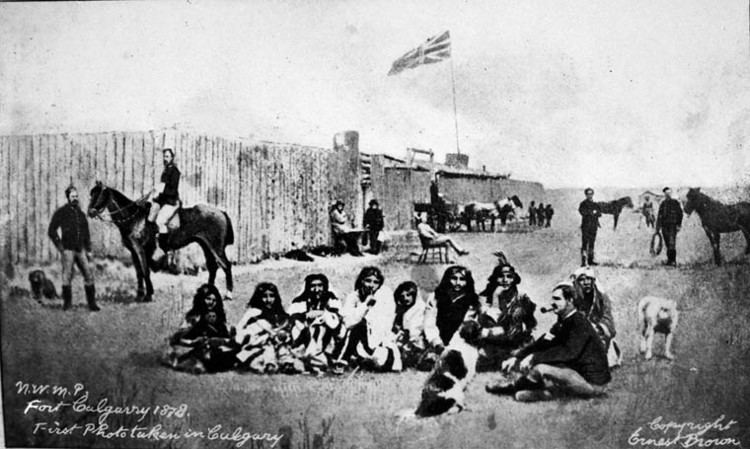Area 2.64 km (1.02 sq mi) Built 1875 | Founded 1875 (used until 1914) Original use Fort | |
 | ||
Fort Calgary was established in 1875 as Fort Brisebois by the North-West Mounted Police, located at the confluence of the Bow and Elbow rivers in what is now Calgary, Alberta. The site was purchased by the City of Calgary in 1974 and reopened in 1978 as a historic site and museum.
Contents
History
The construction of the fort was initiated on April 10, 1875 by a federal order to force out whiskey traders from the area. Commanded by Éphrem A. Brisebois, "F" Troop travelled north from Fort Macleod to find a suitable spot on the Bow for the fort. On arrival at the location they made a makeshift boat with a wagon box and tarpaulins to cross the Bow. Corporal George Clift King was the first member of the troop to set foot on the location, which is why he is sometimes cited as Calgary's first citizen. Construction began in August or September and the fort was completed in time to host Christmas dinner for the local residents.
The fort was constructed out of pine and spruce logs cut upstream and floated to the site. Buildings included men's quarters, a guard room, stables and storage facilities. Shortly after the erection of the fort, two businesses set up operation in the vicinity; I. G. Baker Company and the Hudson's Bay Company.
The post was originally called "The Elbow" or "Bow Fort". Captain Brisebois attempted to rename the fort after himself, but due to his unpopularity, it was renamed Fort Calgary in 1876 by James MacLeod, after Calgary House, a castle at Calgary Bay on the Isle of Mull, Scotland.
With the decline in whiskey and buffalo trade, the fort was down to four constables by 1880. However, in preparation for the arrival of the railway, much of the fort was torn down in 1882 and new barracks were constructed. The arrival of the railway in 1883 and the subsequent rapid growth and expansion of Calgary destroyed the post's reason for existing. A two-storey building that could house 100 men was built in 1888, since a fire in 1884 had destroyed one of the barracks.
Deane House
The Deane House was built nearby in 1906 for the Superintendent of Fort Calgary, Captain Richard Deane. It was originally constructed near 9th Ave and 6th St SE, facing east towards the barracks. Deane felt the previous superintendent's house was not good enough for his wife Martha. Although the budget for the project was $5,000, the total cost was $6,200.
In 1914, The Grand Trunk Pacific Railway bought the land for $250,000 for use as a rail terminal and demolished all the fort buildings except the Deane House. The house was moved to the southeast corner from its original location. The house was then purchased by C. L. Jacques in 1929 and moved across the Elbow River, where it stands today. It was used as a boarding house for several decades until the City of Calgary repurchased the building. In the 1970s it was used as an Art gallery, called The Dandelion Gallery. Today it is a restaurant. The Deane House is being renovated.
In 1969–70, an archaeological crew from the University of Calgary began searching for the Fort at the then current site of McCosham's warehouse. The site was eventually located under a storage yard behind the McCosham's building. The crew unearthed original wooden beams from the Fort and a multitude of historical artifacts.
In 1974, the city of Calgary reclaimed the land and it was designated a provincial and National Historic Site. The present site was reopened on May 18, 1978.
A replica of the 1888 barracks was completed in 2000 at the current fort site, followed by the erection of palisades. The site is operated by the Fort Calgary Preservation Society.
Affiliations
The Museum is affiliated with: CMA, CHIN, and Virtual Museum of Canada.
